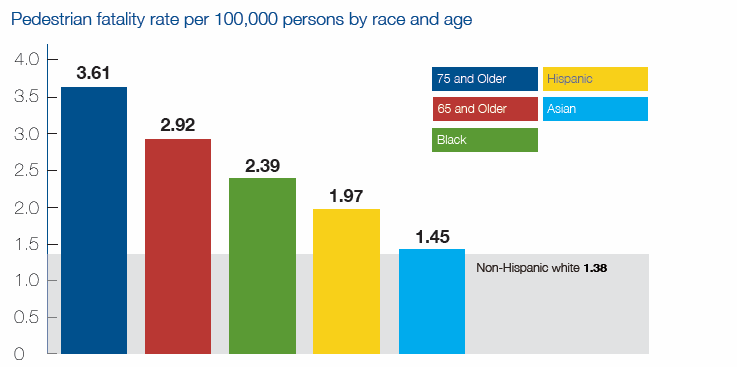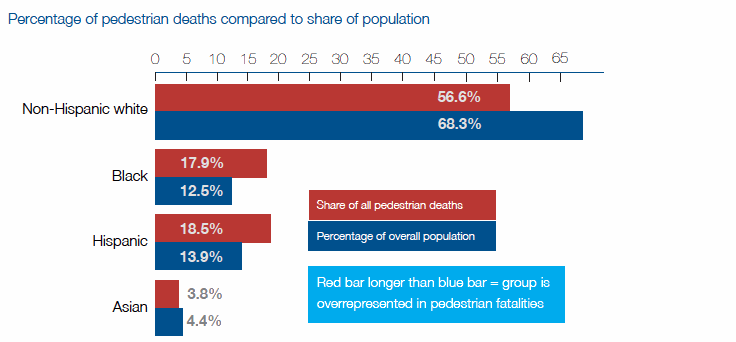TRANSPORTATION FOR AMERICA
Solving the Epidemic of Preventable Pedestrian Deaths
The decades-long neglect of pedestrian safety in the design and use of American streets is exacting a heavy toll on our lives. In the last decade, from 2000 through 2009, more than 47,700 pedestrians were killed in the United States, the equivalent of a jumbo jet full of passengers crashing roughly every month. On top of that, more than 688,000 pedestrians were injured over the decade, a number equivalent to a pedestrian being struck by a car or truck every 7 minutes.
Despite the magnitude of these avoidable tragedies, little public attention – and even less in public resources – has been committed to reducing pedestrian deaths and injuries in the United States. On the contrary, transportation agencies typically prioritize speeding traffic over the safety of people on foot or other vulnerable road users.
Nationwide, pedestrians account for nearly 12 percent of total traffic deaths. But state departments of transportation have largely ignored pedestrian safety from a budgetary perspective, allocating only about 1.5 percent of available federal funds to projects that retrofit dangerous roads or create safe alternatives.
The roads have gotten somewhat safer, but pedestrian fatalities have fallen at only half the rate of motorist fatalities, dropping by just over 14 percent during the period, compared to 27 percent for motor vehicle fatalities. In many places, including 15 of the country’s largest metro areas, pedestrian fatalities have actually increased, even as overall traffic deaths fell.
Children, older adults, and racial and ethnic minorities are disproportionately represented in this figure, but people of all ages and all walks of life have been struck down in the simple act of walking. These deaths typically are labeled “accidents,” and attributed to error on the part of motorist or pedestrian. In fact, however, the majority of these deaths share a common thread: they occurred along “arterial” roadways that were dangerous by design, streets engineered for speeding traffic with little or no provision for people on foot, in wheelchairs or on bicycles.
There is a growing recognition that Americans must increase physical activity, including walking or bicycling, if we are to nudge the needle on ballooning health care costs, reducing obesity and overweight, cardiovascular and other chronic illnesses linked to a lack of exercise. Over the last decade, a growing number of communities have gotten the message, and begun to retrofit their more dangerous roadways to be safer for people on foot, on bicycles and in cars.
Still, most Americans continue to live in places where walking is risky business for their health and safety, where roads are designed solely to move speeding traffic and where pedestrians are viewed as an obstacle.
This has left us with a dilemma: Public health officials encourage Americans of all ages to walk and bike more to stem the costly and deadly obesity epidemic – yet many of our streets are simply not safe. Americans get to pick their poison: less exercise and poor health, or walking on roads where more than 47,000 people have died in the last ten years.
Download full report (PDF): Dangerous by Design 2011
Interactive map: Fatalities by Location
About Transportation for America
www.t4america.org
Transportation for America has formed a broad coalition of housing, business, environmental, public health, transportation, equitable development, and other organizations. We’re all seeking to align our national, state, and local transportation policies with an array of issues like economic opportunity, climate change, energy security, health, housing and community development.








 RSS Feed
RSS Feed